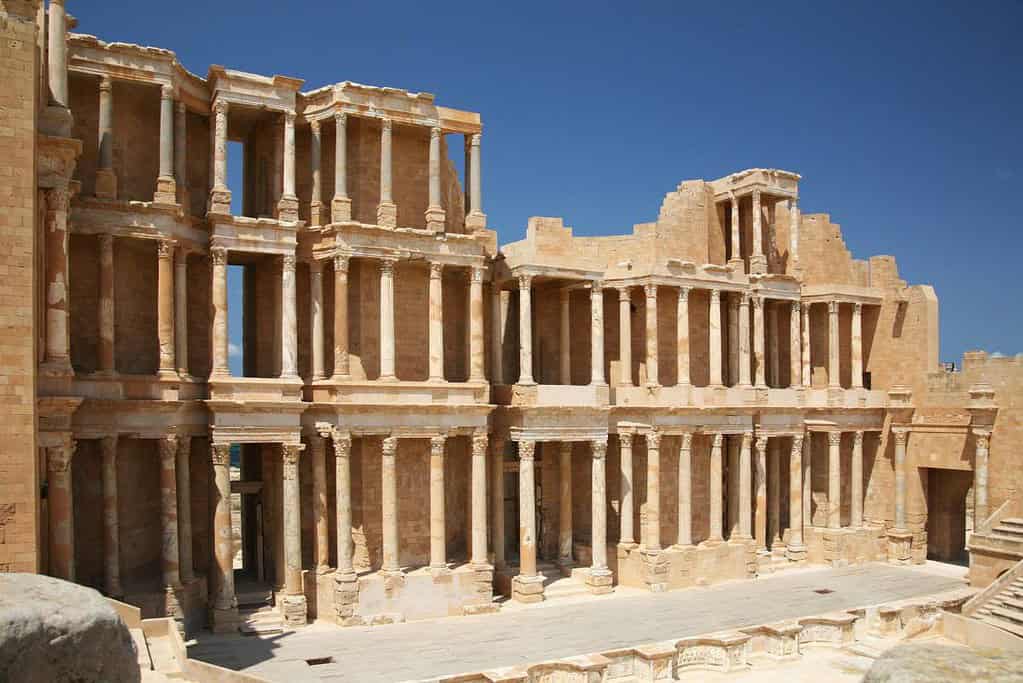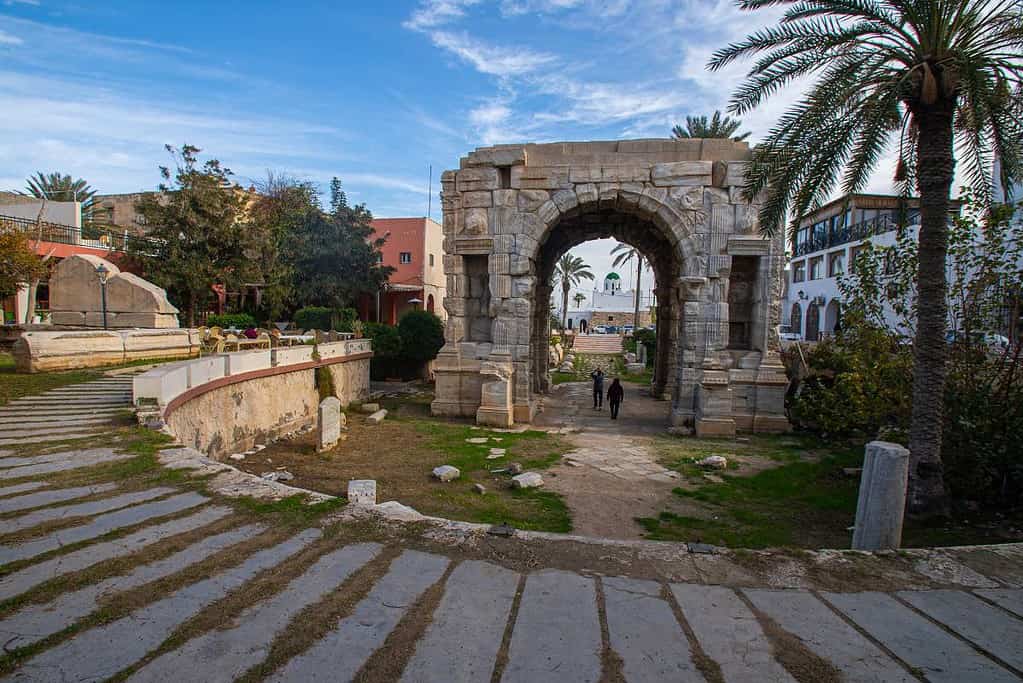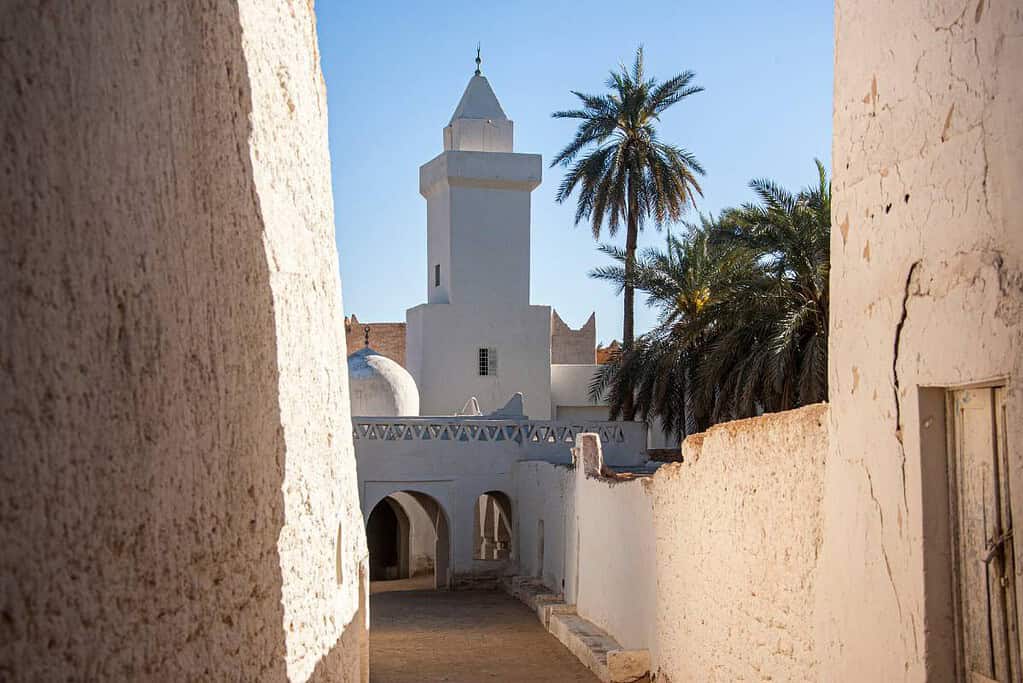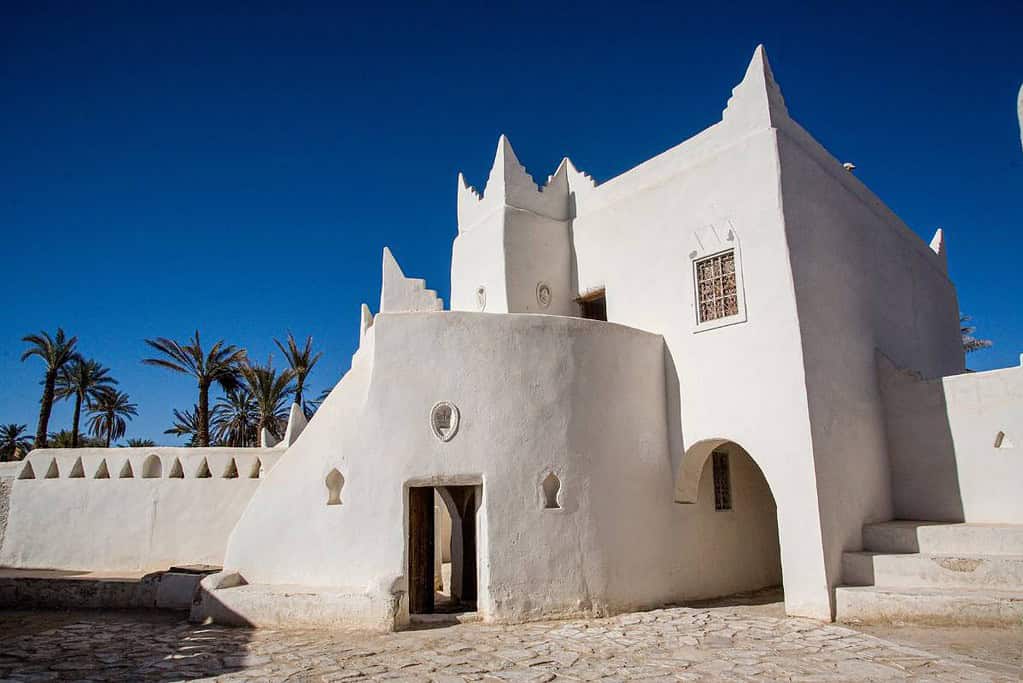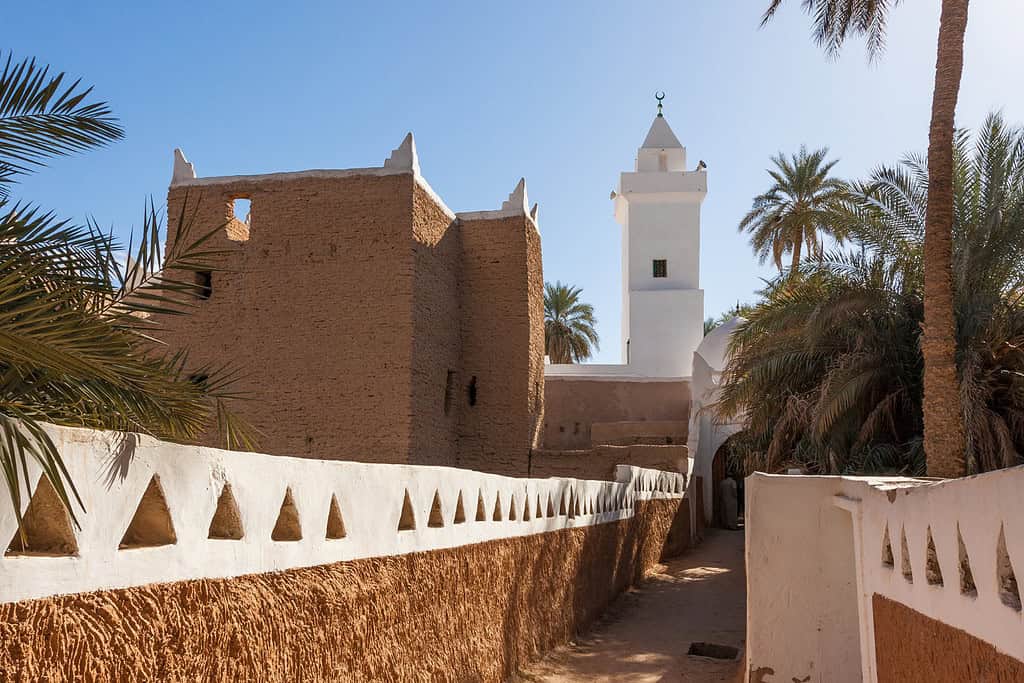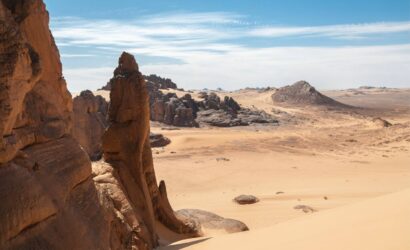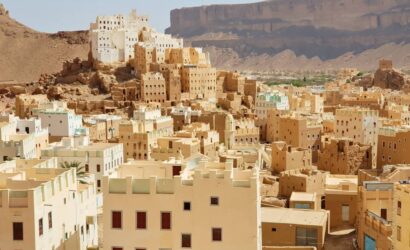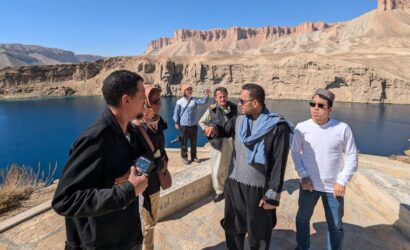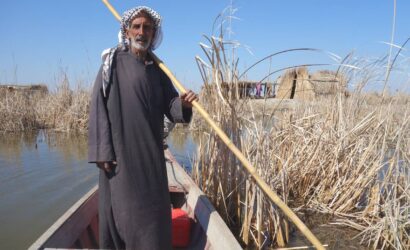This 9-day journey across Libya blends Roman coastal cities, Berber mountain architecture, and the legacy of the Greek Pentapolis. The tour starts in Tripoli and follows a west-to-east route through Leptis Magna, Jebel Nafusa, and Ghadames, before shifting to Cyrenaica in the east via domestic flight. The itinerary is designed for travelers seeking structured historical depth, with visits to monumental ruins, living traditional settlements, and desert heritage zones.
In Tripolitania, the focus is on the Roman port cities of Sabratha and Leptis Magna, which flourished under the Roman Empire, especially during the reign of Septimius Severus. From there, the route heads into the Jebel Nafusa mountains to explore communal fortified granaries like Qasr al-Hajj and traditional Berber towns such as Kabaw. The desert oasis of Ghadames, a UNESCO World Heritage Site, offers an immersive experience in North African Saharan architecture and culture, capped by a desert excursion through dunes and abandoned forts.
The final part of the tour explores Cyrenaica, the Greek-influenced eastern region of Libya. Travelers will explore Apollonia, Cyrene, Ptolemais, and Tokra, once major centers of Greek and later Roman influence. Byzantine churches, Roman temples, and regional museums provide context for how these coastal cities thrived between the 7th century BCE and 6th century CE. The journey concludes in Benghazi, offering a full cross-regional understanding of Libya’s diverse historical landscapes.
Itinerary:
- Day 1 – Only on Thursday » 10:05 Tripoli morning arrival by Turkish Airlines » Airport Meet & Greet » 12:00 Hotel transfer » 14:00 Tripoli Old City Tour (Martyr’s Square, Arch of Marcus Aurelius, Red Castle, Bab Al-Menshia Street, Saraya Market, Gurgi Mosque, House of Yusuf Karamanli)
- Day 2 » 08:00 Tripoli » Leptis Magna » 16:00 Tripoli Corniche Tour (Coastal road, Corniche, Algiers Square)
- Day 3 » 08:00 Tripoli » Jebel Nafusa (11:30 Qasr al-Hajj, 14:30 Kabaw Qasr) » 19:00 Ghadames
- Day 4 » 08:30 Ghadames Old City Tour » 17:00 4WD Desert Safari (Ras Al-Ghoul Fort, Sand Dunes, Touareg Fire Camp)
- Day 5 » 07:30 Ghadames » 10:30 Al Majabrah road » 14:30 Bu Gheilan (Troglodyte Houses) » 17:00 Tripoli
- Day 6 » 07:30 Tripoli » 8:30 Sabratha » Airport transfer » Flight to Al Abraq Airport » Al Bayda
- Day 7 » Al Bayda » Susah (Ancient city of Apollonia) » Archaeological Site of Cyrene » Qsar Libya Museum (West Church, East Church) » Al Bayda
- Day 8 » Al Bayda » Tolmeita (Ancient City of Ptolemais) » Tokra Old City » Benghazi
- Day 9 – Only on Friday » 08:00 Airport transfer // End of our services » 10:15 Benghazi departure by Turkish Airlines
Our tours in Libya and personalized itineraries has been thoughtfully designed around Turkish Airlines daily flights from Istanbul and Tripoli. Specifically, we have aligned our schedule with the flight arriving at Mitiga International Airport (MJI) at 10:05 AM on Thursday, ensuring a comfortable morning start to the tour activities upon your arrival. On the departure day – only on Friday, our tour conveniently concludes in time for the Turkish Airlines flight departing from Benghazi Airport (BEN) at 10:15 PM only on Fridays, allowing travelers a relaxed morning transfer from the hotel to the airport.
Interested in exploring available flight options to Tripoli? Click the boxes below to view more details.
Your morning arrival in Tripoli can be arranged with airlines such as Turkish Airlines, Libyan Wings, Afriqiyah Airways, EgyptAir, and ITA Airways. If your flight timing is different, please inform us so we can assist with logistics. Remember, the Tripoli Old City Tour begins at 14:00.
| Origin City | Airline | Flight No. | Departure Airport | Arrival Tripoli | Arrival Time |
|---|---|---|---|---|---|
| 🇹🇷 Istanbul | Turkish Airlines | TK639 | Istanbul (IST) | Mitiga (MJI) | 10:30 AM |
| 🇹🇷 Istanbul | Libyan Wings | YL101 | Istanbul (IST) | Mitiga (MJI) | 06:00 AM |
| 🇪🇬 Cairo | EgyptAir | MS831 | Cairo (CAI) | Mitiga (MJI) | 09:40 AM |
| 🇹🇳 Tunis | Afriqiyah Airways | 8U451 | Tunis–Carthage (TUN) | Mitiga (MJI) | 11:15 AM |
| 🇹🇳 Tunis | Libyan Wings | YL801 | Tunis–Carthage (TUN) | Mitiga (MJI) | 11:30 AM |
| 🇮🇹 Rome | ITA Airways | AZ868 | Rome–Fiumicino (FCO) | Mitiga (MJI) | 12:10 PM |
This table is illustrative and approximate. Flight schedules can and will change without prior notice, so it serves only as a general guideline for planning purposes. Always confirm your flights directly with the airline.
Your morning departure from Benghazi can be arranged only with Turkish Airlines only on Fridays. Should your flight differ, please inform us to help coordinate logistics. Remember, hotel check-out time is at 12:00.
| Destination City | Airline | Flight No. | Departure Tripoli | Arrival Airport | Arrival Time |
|---|---|---|---|---|---|
| 🇹🇷 Istanbul | Turkish Airlines | TK642 | 10:15 PM | Istanbul Airport (IST) | 01:35 PM |
This table is illustrative and approximate. Flight schedules can and will change without prior notice, so it serves only as a general guideline for planning purposes. Always confirm your flights directly with the airline.
Trip Info
-
Tripoli
-
Benghazi
-
4★ hotels with breakfast
-
Guide and Tourist Police at all time
-
Private sedan, SUV, or van with air conditioning
-
Airport meet & greet with assistance through formalities
-
Tripoli, Cyrene, Apollonia, Tolmeita, Leptis Magna, Sabratha, Jebel Nafusa, Bu Gheilan, Ghadames
-
LOI and visa included — full service for fast e-Visa in 10 days.
Itinerary
Arrival is scheduled at 10:05 at Tripoli Mitiga International Airport via Turkish Airlines. After meet & greet assistance and visa formalities, you’ll be transferred to your hotel by noon, with time to rest before the afternoon program.
At 14:00, the walking tour begins at Martyr’s Square, formerly Green Square, an open plaza surrounded by colonial-era buildings. Nearby stands the Arch of Marcus Aurelius, a Roman triumphal arch dating to 165 CE, the last visible remnant of Roman Oea. Entering the medina through Bab Al-Menshia, you’ll follow narrow lanes to the Saraya Market, pass the Red Castle (Saraya al-Hamra), and visit the 19th-century Gurgi Mosque, known for its octagonal minaret and Andalusian-Ottoman features. The tour ends at the House of Yusuf Karamanli, a preserved Ottoman mansion from the early 1800s.
This introduction to Tripoli highlights how Roman, Ottoman, and local traditions remain physically layered in the urban fabric of the old city.
Travel Distance & Time:
Approx. 35 km – 1 hour total drive
Historical Context:
- Arch of Marcus Aurelius: Built 165 CE under Roman rule in Oea
- Gurgi Mosque: Founded 1834 by Mustafa Gurgi, naval commander under Ottoman Tripoli
- Karamanli Dynasty ruled Tripoli 1711–1835
Curiosities & Local Facts:
- Gurgi Mosque features marble columns repurposed from Roman ruins
- House of Yusuf Karamanli includes original hand-painted wooden ceilings
5 Key Highlights:
- Explore Martyr’s Square and the surviving Roman arch
- Visit Ottoman mosques and 19th-century elite homes
- Discover the role of the Karamanli family in Tripoli’s history
- Walk through Bab Al-Menshia and traditional medina routes
- Learn about how Roman Oea transformed into Islamic Tripoli
Important for You:
Tripoli medina, Ottoman Tripoli, Marcus Aurelius Arch
Depart Tripoli at 08:00 for a full-day excursion to Leptis Magna, located 120 km east along the coast. Upon arrival, you'll enter the site through the Arch of Septimius Severus, built in 203 CE to honor the emperor born here. The tour includes the Severan Forum, Basilica, and Market, all reflecting the city’s peak under Roman rule. The Amphitheater, located near the Wadi Lebda, and the adjacent Hippodrome, illustrate the city's civic and entertainment life.
After exploring Leptis Magna’s core structures, you'll return to Tripoli by 16:00 for a short drive along the Tripoli Corniche. This route passes the coastal road, Algiers Square, and colonial-era facades that show the influence of Italian urban planning in the 20th century.
This visit gives context to how ancient trade shaped the region and how Leptis Magna connected Africa to the wider Roman world.
Travel Distance & Time:
Approx. 260 km – 4.5 hours total drive
Historical Context:
- Leptis Magna: Founded by Phoenicians, expanded under Augustus and Septimius Severus
- Amphitheater: Built 56 CE, seated 16,000 people
- Forum and Basilica: Rebuilt 216 CE under Severan dynasty
Curiosities & Local Facts:
- The Severan Forum columns were shipped from Egypt
- The amphitheater is carved partly into a natural depression near the sea
5 Key Highlights:
- Walk through one of the best-preserved Roman cities in Africa
- See the imperial architecture of the Severan dynasty
- Visit the amphitheater and hippodrome of Leptis Magna
- Drive the Tripoli Corniche and view Italian-era structures
- Observe how Roman North Africa integrated into Mediterranean trade
Important for you:
Leptis Magna ruins, Roman North Africa, Tripoli Corniche
Departing Tripoli at 08:00, the journey enters the Jebel Nafusa, a mountainous region that has long been home to Libya’s Amazigh (Berber) communities. The first major stop at 11:30 is Qasr al-Hajj, a circular fortified granary from the 12th century, known for its distinctive stone compartments and stacked architecture. At 14:30, you’ll stop at Kabaw, another Amazigh settlement with a communal granary and cave homes adapted to the rocky terrain.
By late afternoon, the route continues southwest to reach Ghadames around 19:00. Upon arrival, you’ll check in and rest in preparation for the full city tour the following day.
This day reveals how rural Amazigh communities engineered sustainable living in difficult landscapes.
Travel Distance & Time:
Approx. 630 km – 8.5 hours total drive
Historical Context:
- Qasr al-Hajj: Built in the 12th century for grain storage and tribal management
- Kabaw: Features defensive granaries used well into the 20th century
Curiosities & Local Facts:
- Qasr al-Hajj’s granary system uses no mortar—only dry-stacked stones
- Kabaw’s ancient dwellings are still occasionally used for seasonal storage
5 Key Highlights:
- Visit Amazigh granaries unique to Jebel Nafusa
- Explore the highland villages of Qasr al-Hajj and Kabaw
- Learn about communal resource management in Berber society
- Witness local architecture adapted to arid mountain life
- Arrive in Ghadames, Libya’s famed Saharan town
Important for You:
Qasr al-Hajj, Amazigh architecture, Jebel Nafusa
Begin at 08:30 with a walking tour through Ghadames Old City, a UNESCO World Heritage Site. Known as the “pearl of the desert,” the old town features interconnected homes, rooftop walkways, and a layout designed to mitigate extreme heat. Highlights include covered alleys, the traditional mosque, and preserved Saharan architecture with gypsum and palm wood.
At 17:00, shift to 4WD vehicles for a desert safari through the dunes surrounding Ghadames. Stops include the Ras Al-Ghoul Fort, now a ruin with views of the Tunisian border, and a short trek on foot into the sand dunes. The day ends with a Touareg fire camp, where a simple dinner is served in the open desert.
This experience connects modern visitors to traditional desert life and regional trade history.
Travel Distance & Time:
Local movements only – Approx. 25 km by 4WD
Historical Context:
- Ghadames: Inhabited since Roman times (Cydamus), rebuilt as a caravan post by the 6th century CE
- Ras Al-Ghoul: A Saharan outpost once linked to the Trans-Saharan trade
Curiosities & Local Facts:
- Ghadames homes have separate circulation for women via rooftop paths
- The city's water comes from underground springs feeding a centuries-old irrigation system
5 Key Highlights:
- Walk through the fully preserved old city of Ghadames
- Learn about Saharan climate-adapted housing
- Drive out to Ras Al-Ghoul for desert views
- Trek across dunes in 4WD
- Enjoy a traditional Touareg campfire experience
Important for You:
Ghadames old city, Saharan caravan town, Touareg camp
Departing Ghadames at 07:30, the route retraces toward Tripoli with new stops en route. At 10:30, you’ll follow the Al Majabrah road, passing scattered desert villages and camel-herding zones. By 14:30, you'll visit Bu Gheilan, a remote site known for troglodyte houses—dwellings dug into hillsides for temperature control.
Arrive in Tripoli around 17:00 for rest and dinner at the hotel.
This route highlights traditional Libyan desert life and adaptations to harsh terrain.
Travel Distance & Time:
Approx. 630 km – 8.5 hours drive
Historical Context:
- Troglodyte housing is common in both Libya and Tunisia’s southern zones
- Bu Gheilan’s cave homes date from medieval times and are still occasionally used
Curiosities & Local Facts:
- Cave homes maintain a steady internal temperature year-round
- Local Berber families still visit Bu Gheilan seasonally
5 Key Highlights:
- Drive through desert roads linking Ghadames to Tripoli
- Observe nomadic settlement patterns
- Visit historic troglodyte homes in Bu Gheilan
- Experience Saharan-Libyan desert transition zones
- Return to urban Tripoli from remote southwest
Important for You:
Bu Gheilan cave homes, Libyan desert life, troglodyte dwellings
Depart Tripoli at 07:30 for the short drive westward to Sabratha, one of the key cities of the Roman Tripolitania region. By 08:30, you’ll arrive and begin your visit at the Sabratha Theatre, built in the 2nd century CE and restored during Italian rule. The walk continues through the Temple of Liber Pater, the Forum, baths, and mosaic-covered villas, many overlooking the sea.
Following the site visit, you’ll return to Tripoli for an afternoon airport transfer and domestic flight to Al Abraq Airport, located in Libya’s eastern Cyrenaica region. On arrival, you'll be transferred to your hotel in Al Bayda, arriving in the evening.
This day contrasts Tripolitania’s coastal Roman heritage with Cyrenaica’s upcoming Greek foundations.
Travel Distance & Time:
Tripoli to Sabratha: Approx. 70 km – 1.5 hours drive
Flight Tripoli to Al Abraq: Approx. 1 hour
Al Abraq to Al Bayda: Approx. 20 km – 30 min drive
Historical Context:
- Sabratha: Founded by Phoenicians, became a Roman city in the 1st century BCE
- Theatre: Built under Emperor Commodus around 190 CE
- Liber Pater Temple: A syncretic deity blending Roman and Punic traditions
Curiosities & Local Facts:
- The Sabratha theatre facade is reconstructed from original fragments
- Many floor mosaics were removed to Tripoli’s museum for conservation
5 Key Highlights:
- Visit the well-preserved Roman theatre of Sabratha
- Explore temples, baths, and sea-facing Roman villas
- Understand the Tripolitanian model of Roman urbanism
- Take a domestic flight from west to east Libya
- Arrive in Cyrenaica’s modern capital, Al Bayda
Important for You:
Sabratha theatre, Roman Tripolitania, Al Bayda city
Depart Al Bayda in the morning toward Susah, site of the ancient port of Apollonia. Once Cyrene’s harbor, Apollonia includes a Roman-era theatre, Byzantine basilicas, and baths. After a coastal visit, you'll ascend inland to the plateau where Cyrene lies—one of North Africa’s most important Greek cities. Founded in 631 BCE by settlers from Thera, the site includes the Temple of Zeus, Sanctuary of Apollo, Agora, and necropolis.
In the afternoon, continue east to visit the Qsar Libya Museum, home to the famous floor mosaics discovered in Byzantine churches nearby. The museum holds 50 panels of geometric and symbolic themes that illustrate early Christian Libyan art. Return to Al Bayda by evening.
This day offers deep insight into the Greek and Byzantine history of eastern Libya.
Travel Distance & Time:
Approx. 170 km – 4.5 hours total drive
Historical Context:
- Apollonia: Founded in 7th century BCE as Cyrene’s port
- Cyrene: Major Hellenic city-state in Libya’s Pentapolis; Romanized in 74 BCE
- Qsar Libya mosaics: Dated to 6th century CE, from nearby Byzantine churches
Curiosities & Local Facts:
- The Temple of Zeus at Cyrene is larger than the Parthenon in Athens
- Apollonia’s theater has a rare seaside backdrop, used through the Byzantine period
5 Key Highlights:
- Walk through the Greek city of Cyrene and its sanctuaries
- Visit Apollonia’s harbor ruins and early Christian basilicas
- View rare Byzantine floor mosaics at Qsar Libya
- Understand Greek, Roman, and Christian overlaps in Cyrenaica
- Enjoy scenic drives through the Green Mountains region
Important for You:
Cyrene archaeology, Apollonia Libya, Qsar Libya mosaics
Leaving Al Bayda in the morning, you’ll head southeast along the coastal plain. The first stop is Tolmeita, the ancient city of Ptolemais, another of the Pentapolis cities. Once the regional capital in late antiquity, it features ruins of a vast cistern system, a theater, and remains of Roman streets. The next visit is to Tokra, a lesser-known but strategically located hilltop site. Originally named Taucheira, it has Hellenistic walls, Byzantine churches, and Roman-era domestic remains.
Continue along the road to Benghazi, arriving in the late afternoon. Upon arrival, transfer to your hotel and rest for the evening.
This stop gives context to how urban life evolved in Cyrenaica from Greek colonies to late Roman fortresses.
Travel Distance & Time:
Approx. 270 km – 5 hours drive
Historical Context:
- Ptolemais: Named after Ptolemy III; became regional capital in 3rd century CE
- Tokra (Taucheira): Founded by Greek settlers in 6th century BCE
- Both cities were fortified during Byzantine rule
Curiosities & Local Facts:
- Tolmeita’s cisterns could store up to 20,000 cubic meters of water
- The site of Tokra is rarely visited, despite excellent visibility of wall structures
5 Key Highlights:
- Explore the ancient city of Ptolemais with its unique urban infrastructure
- Visit the little-known Greek site of Tokra on the Mediterranean
- Trace how Greek colonies transformed under Roman and Byzantine rule
- Travel through coastal Cyrenaica to Benghazi
- End the eastern section of the tour in Libya’s second city
Important for You
Ptolemais ruins, Tokra ancient site, Greek Pentapolis Libya
After breakfast, you’ll be transferred from your hotel to Benghazi Benina Airport for your Turkish Airlines departure at 10:15. Airport procedures will be handled in coordination with your guide or driver.
This final morning marks the conclusion of your journey across Libya’s historical and geographical regions.
Travel Distance & Time:
Approx. 25 km – 45 minutes drive
Historical Context:
- Benghazi (ancient Berenice): Another of Libya’s Pentapolis cities, though little remains of the classical core
Curiosities & Local Facts:
- Benghazi was rebuilt after WWII and functions today as a commercial and educational hub
5 Key Highlights:
- End of services and airport transfer
- Final reflections on Cyrenaica's legacy
- Morning logistics managed with local staff
- Departure from Libya’s eastern gateway
- Close of 9-day historical circuit
Important for You:
Benghazi airport, Cyrenaica travel, Libya departure logistics

